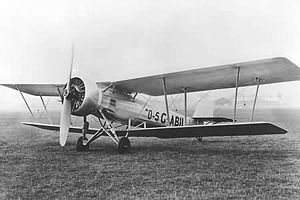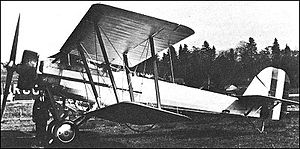Vickers Vespa Video - Picture

|
|
Vickers Vespa
Vespa

Picture - The Vickers Vespa VII which reached a world altitude record
Role: Army Cooperation Aircraft
Manufacturer: Vickers Limited
First flight: 1925
Introduced: 1928
Retired: 1940
Primary users: Bolivia
Irish Air Corps
Number built: 15
The Vickers Vespa was a British army co-operation biplane designed and built by Vickers Limited in the 1920s. While not adopted by Britain's Royal Air Force, small numbers were brought by the Irish Free State and Bolivia, the latter of which used the type during the Chaco War. One modified Vespa was used to set a world altitude record of 43,976 ft (13,407 m) in September 1932.
Design and development
The Vespa was designed by Vickers as a private venture to meet the requirements of Air Ministry Specification 30/24 the first prototype, the Vespa I being flown in September 1925. The Vespa, which was a single-engine biplane with a slim fuselage suspended between closely spaced and highly staggered two-bay wooden wings, was delivered for evaluation by the Royal Air Force, but crash landed owing to engine trouble on 24 June 1926 and was badly damaged. It was then rebuilt with steel, fabric-covered wings as the Vespa II, but this was unsuccessful in getting orders from the RAF.

Picture - Vickers Vespa
It did, however, attract attention from Bolivia, which ordered six Vespa IIIs, an improved all metal version, in 1928, and the Irish Free State, which ordered four Vespa IVs in 1929 and a further four Vespa Vs in 1930.
The prototype Vespa was modified as the Vespa VI for demonstration to the Central Chinese government, but was not purchased, so was returned to Britain. It was rebuilt as the Vespa VII, with a supercharged Bristol Pegasus S engine for an attempt on the world altitude record, setting a record of 43,976 ft (13,407 m) on 16 September 1932.
Operational history
Six Vespa IIIs were delivered to Bolivia in 1928, where they were mainly used as operational conversion aircraft, although they did see limited use in the Chaco War, fought at low altitude rather than the high altitude that Bolivia's Vespas were optimised for. They remained in service until 1935.
The eight Irish Vespas remained in service for several years, operating from the Irish Air Corps base at Baldonnel, near Dublin, with the last being written off on 12 June 1940.
Variants
Vickers Type 113 Vespa I Prototype army co-operation aircraft for evaluation by RAF. Wooden wings. Powered by Bristol Jupiter IV radial engine (later fitted with Jupiter VI. One only (G-EBLD) Vickers Type 119 Vespa II Vespa I modified with metal wings. Vickers Type 149 Vespa III Improved all metal production version for Bolivia. Powered by 455 hp (339 kW) Jupiter VI engine. Six built. Vickers Type 193 Vespa IV Production version for Irish Air Corps. Powered by 490 hp (370 kW) Armstrong Siddeley Jaguar VIC. Four built. Vickers Type 208 Vespa V Improved version of Vespa IV for Irish Air Corps. Fitted with Townend ring around engine. Four built. Vickers Type 210 Vespa VI Rebuilt first prototype, re-registered as G-ABIL and demonstrated to Central Chinese government. Vickers Type 250 Vespa VII Vespa VI rebuilt with Bristol Pegasus S engine for altitude record attempt.
Operators
Bolivia
Bolivian Air Force
Ireland
Irish Air Corps
United Kingdom
Royal Air Force
Specifications (Vespa V)
Data from Vickers Aircraft Since 1908
General characteristics
Crew: Two
Length: 33 ft 0 in (10.06 m)
Wingspan: 50 ft 0 in (15.24 m)
Height: 10 ft 6 in (3.20 m)
Wing area: 576 ft² (53.5 m²)
Empty weight: 2,882 lb (1,310 kg)
Loaded weight: 4,370 lb (1,986 kg)
Powerplant: 1x— Armstrong Siddeley Jaguar VIC 14 cylinder air cooled radial engine, 490 hp (366 kW)
Performance
Maximum speed: 121 kn (139 mph, 224 km/h)
Range: 504 nmi (580 mi, 934 km)
Service ceiling: 26,000 ft (7,900 m) absolute ceiling
Wing loading: 7.59 lb/ft² (36.2 kg/m²)
Power/mass: 0.11 hp/lb (0.18 kW/kg)
Climb: 16 min to 15,000 ft (4,600 m)
Armament
Guns: *1 x— fixed, forward-firing .303 in (7.7 mm) Vickers machine gun
1 x— .303 in (7.7 mm) Lewis Gun on Scarff ring in rear cockpit
Bibliography
Andrews, C.F. and Morgan, Eric B. Vickers Aircraft since 1908, Second edition. London: Putnam, 1988. ISBN 0-85177-815-1.
Donald, David, ed. The Encyclopedia of World Aircraft. London: Aerospace Publishing, 1997. ISBN 1-85605-375-X.
Mason, Francis K. The British Bomber since 1914. London: Putnam Aeronautical Books, 1994. ISBN 0-85177-861-5.
Vickers Vespa Pictures
Living Warbirds: The best warbirds DVD series.
Source: WikiPedia